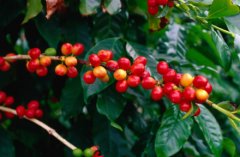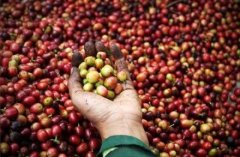How to buy Kenya AA coffee beans Kenya coffee varieties Kenya coffee treatment Washing treatment
Kenyan coffee has many followers in the boutique coffee industry, and Kenyan AA has an extraordinary popularity.
Kenyan coffee, known as the "Cup of connoisseurs" (Connoisseurs'Cup), is famous in the coffee industry for its rich aroma, bright and vibrant acidity, full and elegant mellowness and red wine flavor. Caffeine in different producing areas has its own subtle flavor due to the difference of microclimate.
Kenyan coffee varieties
Bourbon Bourbon was first brought to Kenya for planting. In the 1950s, the then agricultural research institution ScottLaboratory selected two excellent hybrids, SL-28 and SL-34, through unremitting efforts, subverting the long-standing prejudice that artificial breeding is not superior to natural varieties. SL-28 and SL-34 help Kenyan coffee to form its own unique flavor characteristics and establish a perfect reputation in the coffee industry.
Like the choice of other coffee producing countries, although SL-28 and SL-34 have stood the test of time and cultivated generation after generation of faithful pumps for Kenyan coffee, for the sake of coffee yield and disease resistance, the Kenyan government and coffee research institute have begun to promote a new variety, Ruiri11, and the promoters assure coffee lovers that the new variety still has the classic flavor of Kenyan coffee. However, the continuous efforts have not won the recognition of coffee gluttons, who agree that the new varieties lack taste and that the future of Ruiru11 remains to be seen.
In addition to the prestigious traditional Arabica coffee, robusta coffee is also produced in the western lowlands of Kenya.
Coffee growing area in Kenya
The coffee producing areas in Kenya are mainly concentrated in the plateau areas represented by Mount Mt.Kenya. Tropical climate, acid red volcanic soil provides a natural and suitable growth environment for coffee. The seven major producing areas are the most famous, including Nieri, Sika, Chianbu, Geliniya, Ruiru, Mulanga and the western side of Mount Kenya, with the main producing areas such as Nyeri and Ruiru in the middle.
Kenyan coffee processing
Large farms usually have independent treatment facilities. A large number of small farmers usually pick ripe coffee fruits by hand. Coffee picking is a labor-intensive job that requires the whole family to deploy and even hire workers during the harvest season. The fresh fruit of the picked coffee needs to be delivered in time to the cooperative-owned coffee processing plant for pulping, which may be carried by ox carts, pick-up trucks or trucks. After peeling, Parchmentcoffee is briefly kept in the cooperative's processing plant and sent to a privately owned factory for shelling treatment.
Kenyan coffee grade
Kenya is a well-known producer based on the size of coffee beans. Usually divided into nine grades, according to the bean type, there are PB, that is, round beans, accounting for about 10% of the total output, in addition to E (elephant beans), AA, AB, C, T, TT, MH, ML according to size. The best coffee grade is bean berry coffee (PB), followed by AA++, AA+, AA, AB and so on.
Usually Kenyan coffee is classified as follows:
1) Common categories:
Hand-picked coffee fruit, picked by hand, picked out immature fruit (unripe), overripe fruit (overripe) and other defects, peeled, after about 36 hours of fermentation, placed on a metal grid for sun drying, in the processing plant to remove the seed shell (parchment), become a blue-green appearance of attractive Kenyan raw beans.
These beautiful raw beans are graded according to particle size (size), shape (shape) and weight (weight):
E:kenyaE, elephant beans, elephantbean,18 and above (including round beans)
Round beans containing large grains, like PB, are small in quantity.
AA:KenyaAA,17-18 mesh
AB:KenyaAB,15-16, which is a mixture of An and B.
Grade An above 17 mesh (6.8mm), grade B above 16 mesh (6.3mm)
Light beans selected by TT:AA and AB by airflow separator
Over PB:KenyaPB,15, round beans and peaberry account for about 10% of Kenyan coffee.
CRV 12-14 mesh and PB light bean screened by air flow separator
Under 12 eyes, there are more defective beans, chopped beans and light beans.
HE: beyond the above level becomes HE (HulledEars)
2) the raw beans without official standard grading are UG (ungrade).
E,AA,AB,PB → UG1
C,TT,T,HE → UG2
3) MBUNI (sun beans, non-washing treatment)
All raw beans are sorted by gravity (gravityseparator)
MH:heavymbuni, heavy beans, yellow, free of black beans, fragments, dried fruit or other defects
The cup test shows a typical sun flavor with no taste defects.
ML:lightmbuni yellowish green, with a small amount of worm-eaten beans or black beans, no stinky beans or fragments
There is no earthy or other bad taste in the cup test.
(note: 1. Screen, 18 mesh = 18 stroke 64 inches, 1 inch = 25.4 mm)
Taste
Kenyan coffee has an irresistible aroma, and the best Kenyan coffee has strong acidity, reminiscent of ripe blackcurrants, oranges or cherries. At the same time, Kenya coffee has a strong raspberry aroma, such as blueberry, often with rose fruit, passion fruit and floral aroma, with a BlackBerry and grapefruit flavor, is a favorite of many coffee glutton.
This coffee has an excellent medium purity, crisp and refreshing taste. It has a fresh flavor and is most suitable for drinking iced coffee in summer. When tasting this coffee, if it is paired with sour fruits such as grapefruit, it will certainly give you the best coffee experience.
Recommended item [KenyaNyeriGatugiAA]
Country: Kenya
Grade: AA
Production area: Nyeri Central Dashan area
Altitude: 1600-2300 m
Soil quality: volcanic clay
Treatment: washing
Variety: SL28,SL34
Processing plant: Gatugi processing plant
Producer: small coffee farmers
Flavor: floral aroma, blackcurrant, cranberry

Important Notice :
前街咖啡 FrontStreet Coffee has moved to new addredd:
FrontStreet Coffee Address: 315,Donghua East Road,GuangZhou
Tel:020 38364473
- Prev

Introduction to the flavor of Tanzanian boutique coffee taste characteristics of Tanzanian coffee
Gourmet coffee has soft acidity and attractive aroma, which is absolutely worth enjoying. Coffee exports from Tanzania (Tanzania) play an important role in the whole national economy. Bean-shaped berry coffee is very productive and is said to be more fragrant than ordinary coffee. Generally speaking, the coffee beans in Tanzania have an extraordinary quality. For example, in the neighborhood of Kilimanjar
- Next

Introduction of Ethiopian Fine Coffee Flavor characteristics of Ethiopian Coffee
Ethiopia is an agricultural country with a history and tradition of coffee origin. The place where the name coffee comes from is Kafa in the southwest, while the Sidamo place in the south is the main producing area, and Yegashafi is one of the southern producing areas of Sidamo. The Eastern Highland Hara is as famous as the coffee name Hara. Ethiopia is an important coffee producer.
Related
- Does Rose Summer choose Blue, Green or Red? Detailed explanation of Rose Summer Coffee plots and Classification in Panamanian Jade Manor
- What is the difference between the origin, producing area, processing plant, cooperative and manor of coffee beans?
- How fine does the espresso powder fit? how to grind the espresso?
- Sca coffee roasting degree color card coffee roasting degree 8 roasting color values what do you mean?
- The practice of lattes: how to make lattes at home
- Introduction to Indonesian Fine Coffee beans-- Java Coffee producing area of Indonesian Arabica Coffee
- How much will the flavor of light and medium roasted rose summer be expressed? What baking level is rose summer suitable for?
- Introduction to the characteristics of washing, sun-drying or wet-planing coffee commonly used in Mantenin, Indonesia
- Price characteristics of Arabica Coffee Bean Starbucks introduction to Manning Coffee Bean Taste producing area Variety Manor
- What is the authentic Yega flavor? What are the flavor characteristics of the really excellent Yejasuffi coffee beans?

